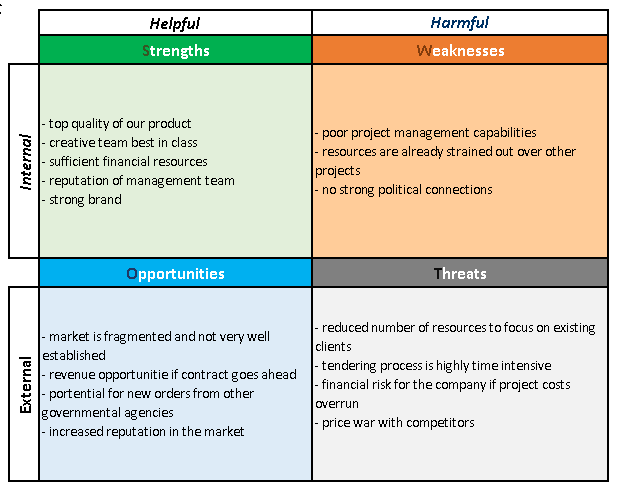SWOT Analysis
What Is SWOT Analysis?
A SWOT Analysis is a widely accepted tool used for strategic planning, which evaluates the internal and external factors in the environment (things you can and things you can't control, respectively) that can be helpful or harmful to your organization, project, product, or idea. SWOT usually represented in a 2x2 grid, where each section represents one of the areas of the analysis.

What Does SWOT Mean?
SWOT stands for Strengths Weakness Opportunities Threats.
Strengths:
This section is where you should list everything that are you are particularly good at, either individually or as a team and organization. This can include strengths such as a motivated team, existing client relationships, or a unique feature of your product.
Questions that assist you in identifying your strengths include:
- what skills and capabilities do you and your team excel at?
- what resources do you have?
- what is unique about your project / product / service / idea?
What should you do about it? Build up!
Weaknesses:
This section lists the internal factors that are preventing your from being your very best, placing your business in a competitive disadvantage. These represent areas you need to improve such as knowledge transfer, unskilled resources, poor marketing capabilities, etc.
The following may guide you in identifying your weaknesses:
- what do you not do well?
- what is there that you need to improve?
- what are the gaps in your project / product / service / idea?
What should you do about it? Minimize!
Opportunities:
This section identifies the external factors that can enhance the likelihood of your business' prosperity. These can include a new piece of legislation, favorable exchange rates, or the potential of a partnership with another organization, etc.
The key question to be asked is:
- what opportunities are available to you (e.g. economy, location, trends, partnerships, etc.)?
What should you do about it? Exploit!
Threats:
This section is composed of the external factors that can put your business at risk, such as the introduction of a new tax, the appearance of a substitute product in the market, or an unfavorable consumer trend.
One question should be in your mind:
- what are the threats to your business (e.g economy, location, trends, competition, etc.)?
What should you do about it? Counteract!
What Are The Benefits Of SWOT Analysis?
Simple and practical to use: Being a simple 2x2 grid, a SWOT Analysis is clear to understand and very easy to complete.
Improves focus : A SWOT Analysis ensures that everyone is singing from the same hymn sheet and knows where to focus during the year.
Brings clarity to strategy : Being a conversation starter, a SWOT Analysis allows people to discuss the strategy and identify future goals.
Uncovers unknowns : From hidden threats to neglected strengths, you will likely discover things about the organization/environment that were unknown until now.
Opens new paths : By matching strengths and opportunities, you are more likely to succeed or to identify new possibilities not previously considered.
When To Complete SWOT Analysis?
A SWOT Analysis can be used at any time but is particularly useful when trying to decide if you have what it takes to move forward with a new project / product/ idea, since it outlines in a very clear way what are the pros, cons and risks involved in such endeavour.
SWOT can also be used at the organizational level or even at the individual level, as a way to re-position your unique selling prepositions or to evaluate where you stand in comparison to your competitors.
How To Conduct A SWOT Analysis?
The good news is that we are offering you a ready-to-go template so you just need to do the rest!
Define the objective:
This is the reason why you are doing a SWOT Analysis; or are deciding on a key project, reviewing or existing strategy, or planning to launch a new service?
Complete each section:
Simply add bullet points to each of the 4 area or make it a large collaborative and creative effort and use post-it notes to complete the sections.
Refine the sections:
Try to be as specific as possible, using qualitative and quantitative information. Are you covering all points?
Draw conclusions:
Review the finished SWOT Analysis and check how balances each section is. If the positives outweigh the negatives, you have a winning idea!
Identify and action your strategies:
You have powerful information at hand, use it! Match your strengths with opportunities to make them happen, and convert your weaknesses into strengths in order to reduce the impact of potential harmful factors.
Best Practices In Using A SWOT Analysis
Brainstorm:
Several minds think better than just one. Reach for diverse opinions to ensure that no critical aspect is neglected. You will be amazed with the power of brainstorming!
Be specific:
The SWOT Analysis should be understandable by anyone at any time, thus, you should make it as specific and clear as possible.
Keep the eyes on the prize:
It's easy to forget that a SWOT Analysis is just a mean to something bigger. Use bullet points to not get lost in detail and to remember why you did the SWOT Analysis in the first place.
Pick your battles:
Saying goes that the biggest room in the world is the room for improvement. You will certainly find plenty of things to improve but don't waste your time and effort trying to boil the ocean all at once, pick your critical battles instead.
Communicate:
The better way to generate a sense of purpose and lead to authentic ownership is by communicating. Don't make the SWOT Analysis a secret exercise for Executives only, build it with your teams instead.




